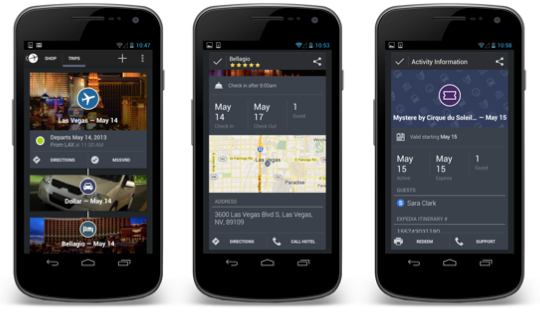Expedia’s migration to a mobile-first company has been slow but steady. Purchasing Mobiata for its FlightTrack data and accompanying apps was one of many small steps the U.S.-based company has taken towards being a true mobile player — it also owns Hotwire and Hotels.com, which are less mobile than they should be — but its presence on Android and iOS has blossomed over the past year.
John Kim, Expedia’s senior vice president of global products, told me that the company’s thesis statement for mobile was “build beautiful apps.” It makes sense: the first thing you see when you open the portal on iOS or Android is a bifurcated list of possible destinations, an aspirational assortment of high-definition photos of London, Paris, Las Vegas, Istanbul. Traditionally, the app has focused less on browsing than transaction; though the iPad version does engender a bit more casual a use case, the majority of customers come to Expedia to buy things.
The steps one takes in doing so is quite satisfying: rich, simple descriptions of resorts, often emblazoned with red ribbon to denote discount, below sharp images of the place. Maps, reviews, amenities, policies. All very direct and approachable.
But Expedia was tired of users leaving the app for good until they needed to book another trip; the company wanted to bring people back, often. “We already made the app extremely usable and fun to browse and easy to book,” continued Kim. Users, he said, also want access to live data. “We want the most up-to-date data at your fingertips. We want it to be dramatically usable — so usable that it sets a new bar for how you want to interact with the app.”
Today’s update, to further that approach, introduces itinerary data. While such information, like flight status alerts, are premium features from companies like TripIt, Expedia thinks this is just the next step of keeping the customer happy.
“What is the job we need to do?” Kim asks, mirroring what his team said was most important. “Our job doesn’t — shouldn’t — end until you finish your trip,” and the new Expedia app wants you coming back. It doesn’t hurt that the new itinerary feature also, almost surreptitiously, invites users to book other products like rental cars or cabs, from within the app, but it is not pushy.
And how are users engaging with the app? By and large Apple is still the most popular platform, but in the last year Android has started catching up. “The back half of last year and most of this year has been more Android,” says Kim. “But there is a difference between browsers and buyers,” referring to the often-discussed disconnect between the amount of money Android users spend on services compared with other platforms. “The distinction over time is starting to close little by little,” but the company still makes far more money from iOS than Android.
As for the iPad, usage has come to be indistinguishable from the desktop, pointing to far more aspirational usage patterns than on the phone. “Tablets are becoming a replacement for the laptop, and behaviour is completely different to the iPhone,” which is still more transactional.
Expedia’s update brings its apps into the live data space, but it’s still so beautiful and easy to use that there’s always a reason to return to the app, even when there’s no trip to book. Because there’s always next time.
Download Expedia for iOS or Android.
MobileSyrup may earn a commission from purchases made via our links, which helps fund the journalism we provide free on our website. These links do not influence our editorial content. Support us here.



